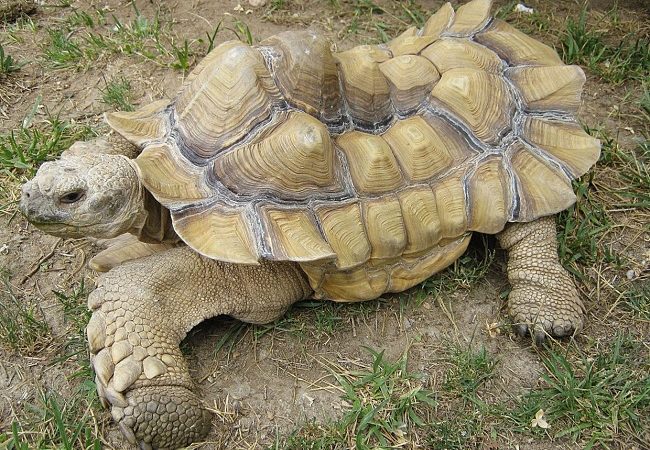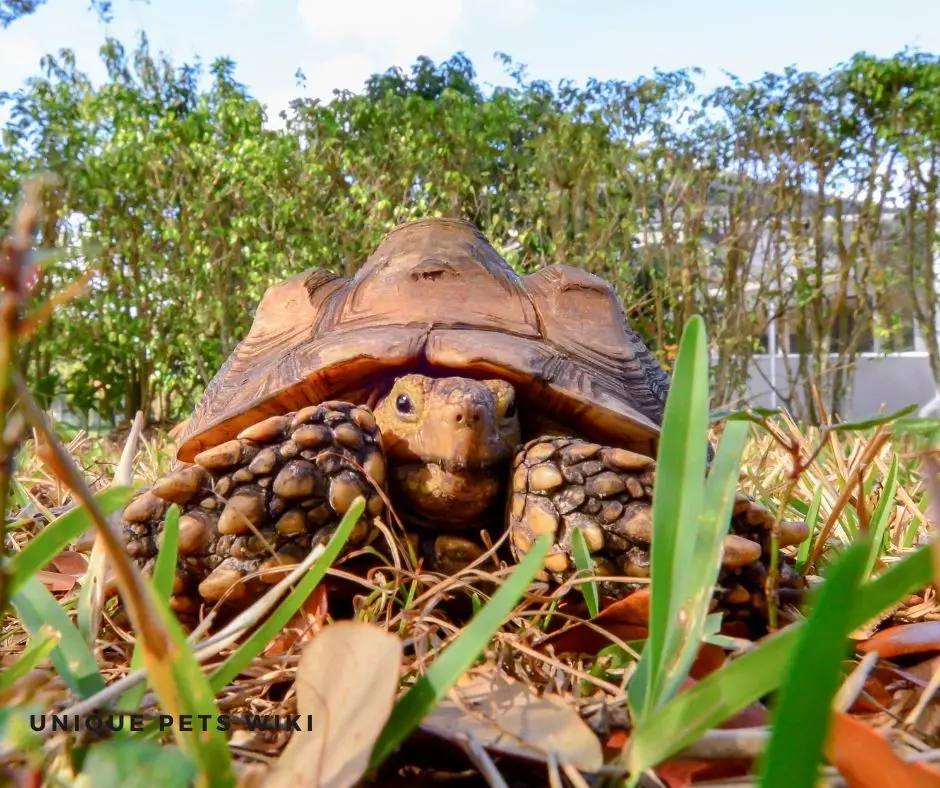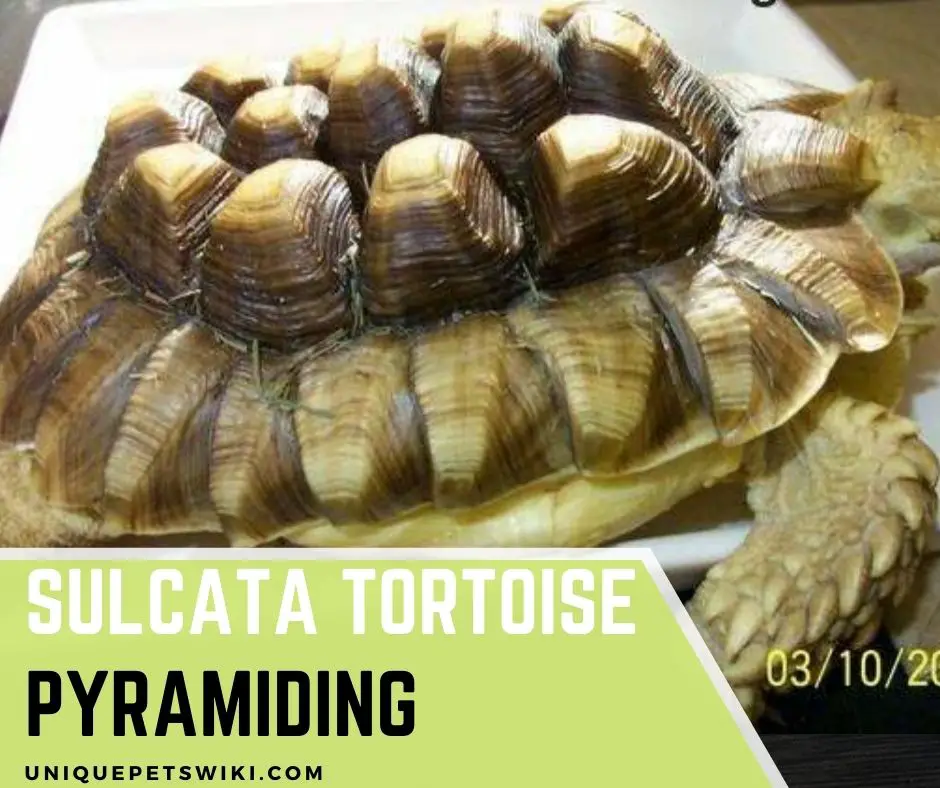“Sulcata Tortoise Pyramiding” – what is it? One of the most prominent features of tortoises and turtles is the shell. These shells usually vary in size, shape, and color, and they serve as a protective exterior. One of the common problems that happen to captive-hatched sulcata tortoises is pyramiding.
Pyramiding, also called pyramidal growth syndrome (PGS), is the condition where the scutes of tortoise rise during the active growth periods in tortoise. It is quite rare to find pyramiding in wild sulcatas, but it is common to see bumpy shells in captive-bred sulcatas.
There are several things that can cause this condition, and you may be wondering why this is happening to your tortoise. In this article, we will help break down everything you need to know about pyramiding in sulcatas, from what causes it to how you can prevent it from happening.
Contents
Sulcata Tortoise Pyramiding – What Is “Pyramiding”?
Many usually believe that pyramiding is a form of metabolic bone disease (MBD). Pyramiding can be characterized as the buildup or stacking of keratin in the scutes. However, in the advanced case of MBD, the tortoise shell will become soft and then flattens out.
Pyramiding in tortoise can be defined as an abnormal upward growth of the scute. The growth usually looks like a pyramid on the tortoise’s shell, so this condition is called pyramiding. Furthermore, pyramiding occurs mostly in the vertebral scutes down to the shell’s center.
However, it can also affect the costal scutes along the sides as well. The signs of pyramiding in tortoises usually range from mild to acute disfiguring. Pyramiding not only looks unnatural in tortoises but is also associated with several health complications ranging from tortoise’s mobility to even death if not treated.

Source – [Pet Sulcata]
Sulcata Tortoise Pyramiding – Causes and Solution To Prevent Pyramiding In Sulcata Tortoise?
There are many things that can cause pyramiding in sulcata tortoise; some of them are stated below.
Incorrect Substrate
Apart from pyramiding, using the incorrect substrate for your tortoise can lead to lots of health conditions. This is why it is important to use the correct substrate to house your tortoise. Most tortoise breeders and owners believe that a moist substrate will become a breeding ground for bacteria and fungus.
Furthermore, it is believed that using a too dry or dusty substrate will cause respiratory infections and pyramiding for your tortoise. You can prevent pyramiding by using damp peat or loam-based substrate for their hides or retreat space.
Improper Diet
Many sulcata tortoise breeders and owners first believed that the major cause of pyramiding in sulcata tortoises is poor diet. However, there are several dietary causes of pyramiding, such as
- Too much protein
- Overfeeding
- Imbalance of calcium and phosphorus
- Too much fat
You can prevent pyramiding in sulcata tortoises by feeding them a high fiber diet. You should ensure variety in their diet and avoid feeding them with too much of any food item except hay and grass.
You can then use darker greens such as collard greens, mustard greens, kale, and turnip greens as a varied diet. However, you should limit how you feed your tortoise as these foods have high oxalates, leading to calcium absorption concerns.
Furthermore, you should avoid feeding your sulcata tortoise, especially the baby and young tortoise, with vegetables and fruits.

A healthy sulcata with healthy scutes is one that is fed balanced diet always.
Lack Of Vitamin D3 And Sunlight
Sunlight is important for the health of your tortoise. Sulcata tortoises can have pyramids if they are not exposed to sunlight. This is because they need sunlight and UVB rays to synthesize vitamin D3 to absorb calcium properly.
Furthermore, their shell can then become damaged if there is not enough vitamin D3 in their body. You can prevent pyramiding by ensuring that your tortoise gets outside as much as possible.
However, if your tortoise cannot get outside, you will need to provide an indoor calcium and vitamin D3 supplement. You can also provide a good artificial UVB light source if you are keeping your tortoise indoors.
Humidity Imbalance (Too High Or Too Low)
Low humidity has been associated with being the cause of pyramiding among sulcata tortoises. This shows how important humidity is, but it is also not recommended to keep tortoises in high humidity. You need to house adult sulcata tortoises in an enclosure that has at least 60 percent humidity.
However, juvenile tortoises can be kept in an enclosure with at least 65% humidity. Maintaining humidity in sulcata tortoise enclosures can be quite hard since they are usually housed outdoors.
Furthermore, you will have a problem keeping tortoises if you stay in an area with humidity levels more than 60% most of the year and want to house your tortoise outside. Some of the steps that you can use to maintain humidity in a tortoise enclosure are listed below.
- Invest in a hygrometer
- Place moisture-retaining substrate in their enclosure
- Mist the enclosure regularly or invest in a humidifier
- Place a humid box in their enclosure
- Bathe the tortoise 2 or 3 times per week

Inappropriate temperature will cause scutes problems such as pyramiding.
Dehydration
Over time a dehydrated sulcata tortoise will begin to show signs of pyramiding. You can treat dehydration in sulcata tortoise by providing enough water to your tortoise. You can soak sulcata tortoises in warm water to ensure that they get enough water.
You can soak a sulcata tortoise once or twice a week. Apart from soaking, you should ensure there is enough water available in the enclosures every time.
Note: you should place a safe water bowl that your tortoise can easily get in and out of whenever they want.
Enclosure Size
Apart from a poor environment, sulcata tortoises can have pyramids if the enclosure is too small. This is because your tortoise will not have enough room to move around and exercise.
Furthermore, lack of exercise can also cause your tortoise muscles and bones to weaken, which can cause abnormalities. You can prevent pyramiding by ensuring that you keep your tortoise in a large enclosure with enough decorations and accessories which help them to move around.

This will ensure it has ample space to explore and exercise.
Other than this, the sulcata will be seriously inconvenient and this may cause health issues.
Why Is Shell Pyramiding Bad?
Shell pyramiding usually occurs because of poor enclosure conditions, improper diet, and/or poor environmental conditions. However, pyramiding can lead to several problems if it is not corrected. It can interfere with the movement of your tortoise and can also lead to disfigured limbs.
In severe cases, shell pyramiding can also affect the spinal cord and cause paralysis. Furthermore, shell pyramiding can cause reproductive issues as the affected female can struggle to lay eggs while the affected male can struggle to mate.

Source – [Redditt]
How To Determine That You Have Got Pyramiding Under Control
After you have discovered the cause of pyramiding in your tortoise, the next thing is to act immediately to help stop the condition from growing. You can easily monitor the situation by taking a picture of your tortoise as they are and then continue to do so over the coming months.
However, you need to ensure you place the tortoise in the same position and take the picture from the same distance and angle. You can then compare the pictures to check your progress.
If you notice that the tortoise condition is not improving, you should take it to the vet to help determine the cause and treat your tortoise.
Wrapping Up
Pyramiding is a common health condition that happens with captive sulcata tortoises. Once the signs of pyramiding start to show, it can be quite hard to reverse them. However, it is very easy to avoid or stop pyramiding in its tracks if you detect it early.
The best thing is that once you take steps to stop the underlying causes of pyramiding, the problem will not worsen.
